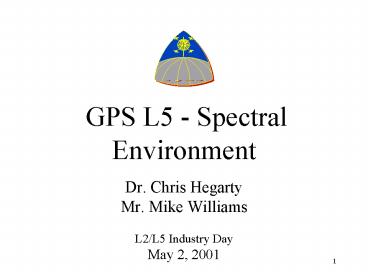GPS L5 Spectral Environment
1 / 15
Title: GPS L5 Spectral Environment
1
GPS L5 - Spectral Environment
- Dr. Chris Hegarty
- Mr. Mike Williams
- L2/L5 Industry Day
- May 2, 2001
1
2
Overview
- L5 will reside in the 960 - 1215 MHz band
- Allocated internationally for Aeronautical
Radionavigation Services (ARNS) - Co-primary Radionavigation Satellite Services
(RNSS) allocation obtained in 2000 for 1164 -
1215 MHz - Band is heavily used, e.g., by ground navaids and
Link 16 - IGEB ad hoc Working Group 1 formed to validate
compatibility
3
L5 Electromagnetic Environment - Primary
Contributors
- DME/TACAN
- Over 1700 U.S. ground beacons
- 1 MHz channels across 960-1215 MHz
- EIRP 100 W - 10000 W
- 3.5 ms pulse width (1/2 voltage)
- 2700 - 3600 pulse pairs/s
- JTIDS/MIDS (Link 16)
- Now 600 terminals (many airborne)
- May be 4000 U.S. terminals by 2010
- Hops over 51 3 MHz channels from 969-1206 MHz
- 6.4 ms pulse width
- For uncoordinated exercises
- Peak power 200 W
- 396,288 pulses/12 s in 200 nmi radius
4
Compatibility Analysis
- Assumptions
- Pulse blanking and robust selectivity
incorporated into L5 user equipment - L5 received power -154 dBW
- Compatibility assessed using signal-to-noise
ratio (SNR) approach - Goal is to maintain post-correlation SNR provided
at L1 - On following charts, 5.8 dB is breakpoint between
acceptable and unacceptable
5
SNR Degradation at 5,000 ft. Above Ground Level -
DME/TACAN Only
Acceptable degradation
Unacceptable degradation
Plots courtesy of Tae Kim and Swen Ericson, MITRE
CAASD
6
SNR Degradation at 40,000 ft. Mean Sea Level -
DME/TACAN Only
7
SNR Degradation at 40,000 ft - All Known U.S.
Emitters
8
SNR Degradation at 40,000 ft - All Known U.S.
Emitters with Reassignment of In-band DME/TACANs
9
Summary
- DME/TACAN is primary contributor to L5
electromagnetic environment, Link 16 secondary - Primarily a concern for high altitudes in only a
few regions of the world - DME reassignments (within /-9 MHz of L5), as
necessary, will ensure excellent L5 reception at
all altitudes in U.S. - Validated by simulation
- Hardware tests planned in FY02
10
Backup
11
Receiver Requirements
- Primary contributors to electromagnetic
environment near L5 are pulsed - More selective front-end (compared to L1
avionics) necessary to limit number of pulses
desensitizing receiver - Pulse blanking a low-cost, low-risk method to
minimize effects of pulses on receiver
performance - Performance standards should not specify design,
but will require operation in pulsed environment
12
IGEB-assumed Receiver Selectivity
- RTCA consensus was that 5.5 dB/MHz is maximum
RF/IF roll-off that can be - reasonably achieved considering
- Component cost vs. performance
- Package size of installed active antennas and
avionics
13
Receiver Noise Floor
- L1 avionics specifications assume noise floor of
-201.5 dBW/MHz - Consistent with 4 dB Noise Figure
- Increased selectivity for L5 comes at a price
- Increased insertion loss raises noise floor
- WG1 developed values for L5
- 5 dB Noise Figure
- Noise floor of -200.0 dBW/MHz
14
L5 Active Antenna Noise Figure Budget
L5
BPF
Lim
LNA
Diplexer
cable
Rx-Proc
3-4 pole -2.0 dB
-0.7 dB
Z-mismatch -0.2 dB
G30 dB F1.8 dB
L1
2-3 pole -1.4 dB
-13 dB
-0.3 dB
NF ? 8 dB
- Allowance made for added filter, limiter losses
for tough L5 RFI - increased antenna unit selectivity for less LNA
off-channel overload - higher loss 2-stage limiter for high peak power
on-board transmitters - L5 Rx System Noise Temperature 625 K (5.0 dB
NF) - Sky Temp. 100 K Overall Ant. Input Temp.
725 K (-200 dBW/Hz)
Courtesy of Bob Erlandson, Rockwell-Collins. A
similar budget was independently derived by Dan
Bobyn, a former Novatel RF design engineer.
15
Example of Worst-Case DME/TACAN Environment
Victim aircraft at 40,000 ft over Harrisburg
Note Only TACAN/DMEs with frequency assignments
from 1157 - 1209 MHz are shown/analyzed.































